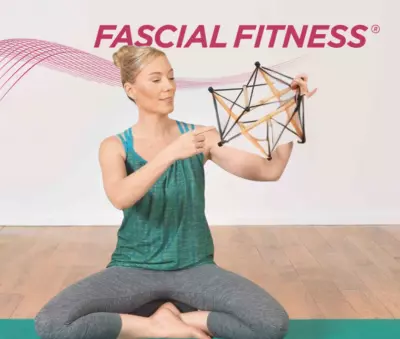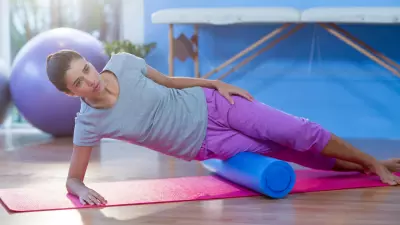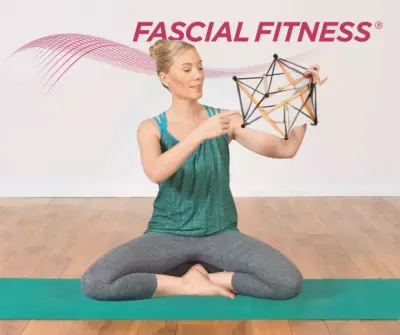Here’s a thought: maybe your fascia doesn’t need more grind… maybe it needs more grace.
And not just any recovery… therapeutic, sensory-rich, fascia-friendly recovery that balances stress, supports healing, and reminds us that the connective tissue system isn’t just a powerhouse… it’s also a sensitive communicator.
Fascia as a Healing Interface
Fascia is reactive. It responds to pressure, temperature, breath, and emotion. That means we can influence it through touch, awareness, and gentle inputs just as much as we can through dynamic movement.
When we’re stressed, over-trained, or underslept, the fascia stiffens. Blood flow decreases. The gel-like matrix becomes more glue-like. Schleip describes this as fascia shifting into “freeze mode,” where tension becomes sticky, chronic, and resistant.
The antidote? Gentle coaxing, not force. That’s where these recovery strategies come in.
Yoga: The Ancient Fascia Whisperer
Modern yoga, with its flowing sequences and long-held stretches, offers two key benefits for fascia:
- Dynamic elongation of fascial chains (think spiral stretches, long lunges, backbends)
- Parasympathetic activation — in other words, it calms your nervous system, which softens fascia indirectly
Even without calling it “fascia training,” certain yoga lineages (like Yin, Restorative, and some Vinyasa styles) naturally incorporate the slow, stretchy, and breath-driven movements that Schleip recommends.
The catch? Not all yoga is fascia-friendly. If it’s rigid, performance-focused, or overly repetitive, it can miss the mark. The key is sensation over shape.
Manual Therapy: More Than Muscle Rubs
Fascia responds beautifully to hands-on therapy, but not all hands are created equal. Schleip highlights a few modalities that have fascia written into their DNA:
1. Classic Massage
While it can offer temporary relief, conventional massage mostly targets muscles. Deeper fascial release often requires slow, sustained pressure — something more common in methods like myofascial release.
2. Rolfing
This one gets a big nod. Rolfing (aka Structural Integration) was created by fascial pioneer Ida Rolf. It’s a full-body method of realigning posture through deep fascial manipulation. The work is intense — but intentional. It helps reprogram ingrained tension patterns in the fascial web.
3. Osteopathy
A bit of a dark horse in the manual therapy world, osteopathy uses gentle adjustments and mobilizations to influence deep connective tissue and restore internal mobility — especially around joints and viscera.
4. Acupuncture
Yes, acupuncture makes the list — not because it stretches fascia, but because needling can influence fascial tone. Schleip mentions new research showing how needles can stimulate fibroblasts (the cells that produce fascia) and promote fluid movement.
Pilates: Fascia-Approved Core Control
Pilates often gets lumped in with “core” work, but when done well, it’s sneaky-good fascia training. Why?
- It emphasizes whole-body coordination
- Movements are rhythmic, spiraled, and resisted (great for fascial recoil)
- Breath and awareness are central
Schleip encourages movement pros to look beyond the equipment and cues, and into the tissue-level impact of a Pilates session. For fascial health, it’s not about how many hundreds you can do — it’s about how fluid and connected you feel while doing them.
Are All “New Trends” Worth It?
Fascia is slow to adapt. You don’t remodel connective tissue in a weekend. Be wary of programs that promise instant transformation through gadgetry, extreme stretching, or aggressive manipulation. Schleip reminds us: respect the tissue.
So, What’s the Big Message Here?
Recovery isn’t just about rest… it’s about rebalancing your fascial system through smart inputs. That includes:
- Manual therapies that use slow, precise pressure
- Movement modalities that prioritize breath, flow, and interoception
- Self-care that emphasizes down-regulation, not just “no pain, no gain”
If fascia training is a symphony, recovery is the silence between the notes — necessary, powerful, and often neglected.
Final Thought: You Can’t Roll Out Burnout
You can do all the foam rolling and stretching you want, but if your fascia is constantly bracing due to stress, inflammation, or lack of recovery, you’ll stay stuck.
The real win? Integrating these gentle methods as core parts of your program, not just emergency tools when pain shows up.
Take the long view. Your fascia certainly is.

Unlock your full potential as a movement professional
Become a Certified Fascial Fitness Trainer
Join our 10-week virtual mentorship program, featuring live calls with fascia research pioneers—including Dr. Robert Schleip himself. Deepen your understanding of fascia-focused training, gain exclusive insights from leading experts, and get hands-on guidance to confidently integrate this cutting-edge approach into your practice.


